
Manual Handling Training. Legal Requirements & Policy. What is it and why bother?. Injury causation. Principles of safe handling. Summary. Manual Handling Operations Safety. Legal Requirements. Manual Handling Operations Regulations 1992.

spike + Follow
Download PresentationAn Image/Link below is provided (as is) to download presentation Download Policy: Content on the Website is provided to you AS IS for your information and personal use and may not be sold / licensed / shared on other websites without getting consent from its author. Content is provided to you AS IS for your information and personal use only. Download presentation by click this link. While downloading, if for some reason you are not able to download a presentation, the publisher may have deleted the file from their server. During download, if you can't get a presentation, the file might be deleted by the publisher.

MANUAL HANDLING. Course Content. Introduction Statistics Law Anatomy & Injuries Biomechanics Principles of Safe Handling. What is Manual Handling?.
878 views • 24 slides
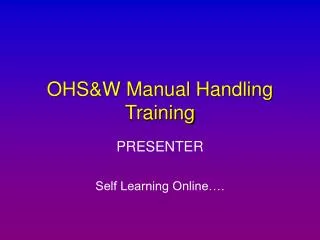
OHS&W Manual Handling Training. PRESENTER Self Learning Online…. We don’t come to work to get hurt!. Manual Handling Course Outline. Identification of Issues Risk Assessment Control Options Exercise Evaluation. Manual Handling occurs when:. Lifting Lowering Pushing Pulling Carrying
1.02k views • 25 slides
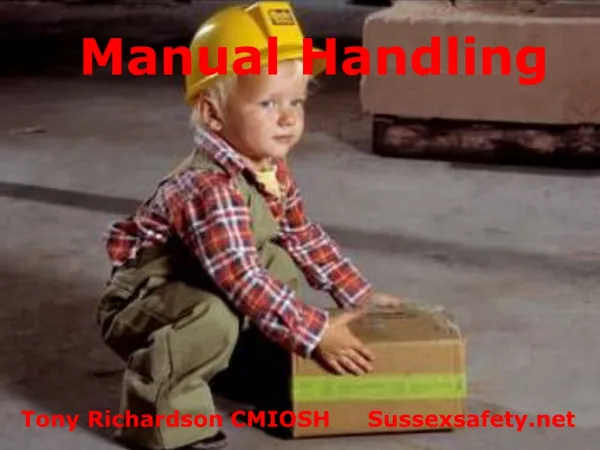
Manual Handling. Tony Richardson CMIOSH Sussexsafety.net. Sussexsafety.net Training Presentation: Manual Handling. Introduction-aims of the session. An awareness of manual handling injuries An overview of legal requirements
1.44k views • 31 slides

Manual Handling. What is Manual Handling. Manual Handling is the movement of loads using physical effort. It includes the lifting, lowering, pulling, pushing, carrying and supporting of loads. The Manual Handling Operations Regulations - Employers Duty.
1.01k views • 15 slides
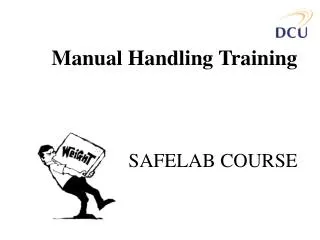
Manual Handling Training. SAFELAB COURSE. Introduction. Legislation Anatomy Ergonomics Principles of lifting. At the end of this session you will be able to: Basic understanding of your back Understand principles of safe manual handling Know when to stop!. Objectives. Did You Know ?.
577 views • 24 slides

Heritage Group Safety. MANUAL HANDLING. THINK BEFORE YOU LIFT. Course Objectives. Learn to appreciate: The extent of the problems caused by incorrectly moving loads. Thinking through moving a load. Taking a few minutes to assess the manual handling.
1.28k views • 22 slides

Manual Handling. Dr. Ann Maconnachie Departmental Safety Officer. Manual Handling. Plan the lift Position the feet Adopt a good posture Get a firm grip Keep close to the load Don’t jerk Move the feet Put down, then adjust. Manual handling. Stop and think Plan the lift
750 views • 5 slides

Manual Handling. Ian Stone Health and Safety Advisor. Aims and Objectives. Provide sufficient understanding and knowledge of Manual Handling, the risks involved and the control measures available. . How?. Theory Discussion Practical Demonstrations. What Is Manual Handling?.
1.41k views • 60 slides

Manual Material Handling. Back Injury Facts 70% of cases – Average weight of object lifted was 40-100# and 30% were over 100# The distance traveled at the time of injury was less than 5 feet 50% of the cases, the object was lifted from the ground level
787 views • 27 slides

Manual Handling. At the end of the course employees will: be aware of manual handling as an important occupational health and safety issue know the risk factors of manual handling operations that can lead to injury . Session 1 Manual Handling Awareness.
735 views • 17 slides

Manual Handling. What is manual handling?. Manual Handling is….. Any activity requiring the use of force exerted by a person to: Lift Lower Push Pull Or otherwise: Move Hold Restrain. When does this occur in Child Care?. Lifting children and objects Moving things off the ground
2.15k views • 18 slides

Manual Handling. Soft Skills Programme. Nexus Alliance Ltd . Session Elements. 1. Definition. 2. Injuries and Statistics. 3. Anatomy of the Spine. 4. Risk Assessment. 5. Safe Handling Techniques. 2. Mechanical Aids. Definition.
791 views • 41 slides

Manual Handling. Dietsmann HSE Awareness Campaign. Let Safety be your Guideline! Prevent fatigue, prevent injuries, prevent accidents Handling: take care of your spine, muscles and hands Prevent risk of musculoskeletal disorders (MSD). You need your hands! Be aware of every risk
454 views • 19 slides

Manual handling. Parson’s Engineering. Insert Image Here. Manual handling. Manual handling is the handling of objects in a physical capacity, and the correct techniques to do so.
540 views • 10 slides

MANUAL-MATERIAL HANDLING. Pendahuluan. Mekanisasi >> msh > pekerjaan yg hrs dilakukan secara manual – mengandalkan kekuatan manusia LBP Fakta : 20% cedera punggung Work related- bisa diatasi dengan teknik manual handling yg benar. Statistics.
1.8k views • 56 slides

Manual Handling. Manual Handling Definition. Any activities requiring the use of force by a person to lift, lower, push, pull, carry, move, hold or restrain a person or an object. What work techniques can help prevent manual handling injuries?. A. Planning the lift Check clear pathways
1.39k views • 8 slides

Manual Handling. Load Handling Including Induction. Who Are We? LINDA CURSON Back Care Advisor Ext 2107, Bleep 401 KATHERINE HOPKINSON Manual Handling Trainer Ext 5457, Bleep 031. The Back Care / Manual Handling Team. What Do We Do? Includes: Training for all levels of staff
1.1k views • 61 slides
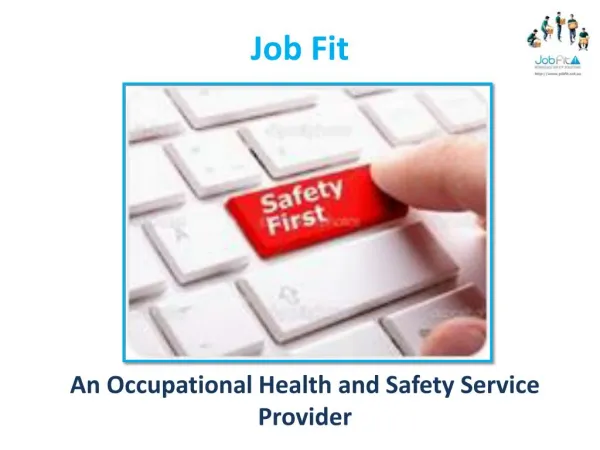
Around one third of all workplace injuries in Australia occur during manual handling activities. Many of these injuries could have been avoided with good preventative interventions. Please contact us on (03) 5977 0222 or visit our http://www.jobfit.net.au
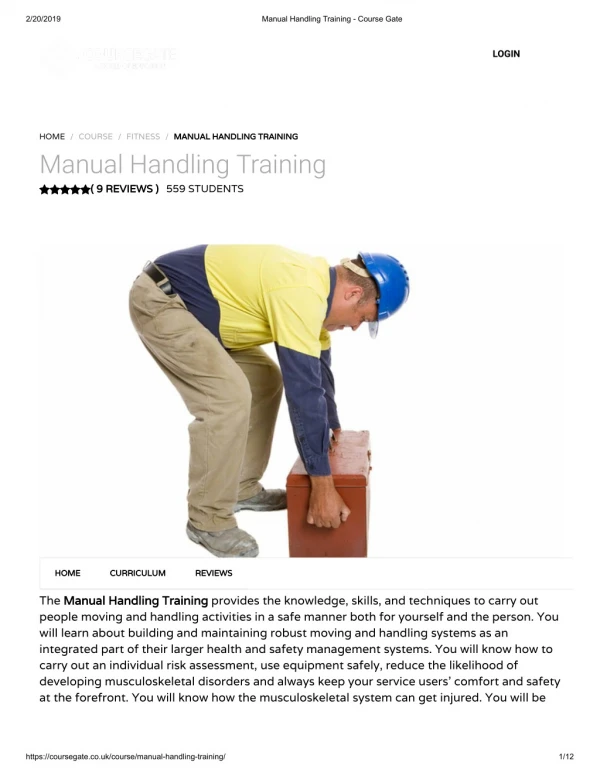
The Manual Handling Training provides the knowledge, skills, and techniques to carry out people moving and handling activities in a safe manner both for yourself and the person. You will learn about building and maintaining robust moving and handling systems as an integrated part of their larger health and safety management systems. See More: https://bit.ly/2E0ZSKv
203 views • 12 slides